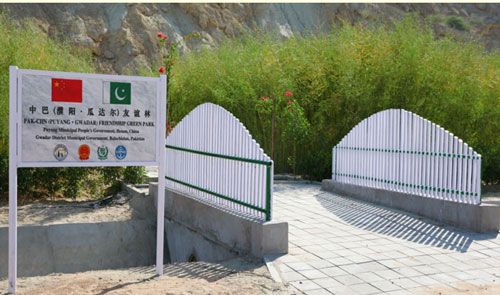By Chu Daye
During the COVID-19 pandemic lockdown, the Chinese port operator at Pakistan’s southwest Port of Gwadar focused its attention on forest-planting, and has now successfully completed a friendship forest in a city situated in a desert climate, gifting the city its first ever green park.
At the foot of the area’s Koh-e-Batil Hill, the forest spreads across 60 mu (4 hectares) of land provided by the Pakistani government for free. The construction of the park was supported by the local community and the Pakistani Navy, which promptly relocated its camps and buildings in just two weeks to evacuate the land needed for forest planting.
Located in Pakistan’s southwest province of Balochistan, Gwadar Port is a key project of the China-Pakistan Economic Corridor (CPEC), a flagship project of the China-proposed Belt and Road Initiative (BRI). Since its operation, the port has begun to play a new role as an economical transit stop and time-saving trade port for land-locked Afghanistan when it ships fertilizer.
To build a forest in Gwadar’s desert climate with almost no rain is no easy task, and the China Overseas Ports Holding Company – the port’s operator – joined hands with the city government of Puyang, in Central China’s Henan Province, to work toward the target of affording the local community a green park in as short a time as possible that would have low maintenance costs and be easily accessible.
The most advanced irrigation technology is applied here, a manager of the forest park’s builder said, noting that the building of the forest received on-site guidance by a team of Chinese agriculture experts.
A total of 100,000 trees, shrubs and flowers that resist high-temperature, high saline-alkali soils were planted, with a 10,000-meter-long irrigation pipeline system, and a storage tanker holding up to 3,000 cubic meters of water, according to the company.
“It takes us about 10 months to complete the friendship forest, roughly coinciding with the time period of the pandemic, and we are continuing work to improve the park and the forest,” Zhang Baozhong, chairman of China Overseas Ports Holding Company, told the Global Times.
The fact that a forest of this size can be added to the extremely hot and dry land of Gwadar in such a short time shows how much importance China’s BRI builders attach to the concept of green development – a concept also specifically implemented in China to help work toward a sustainable ecological civilization, analysts pointed out.
Xu Liping, director of the Center for Southeast Asian Studies at the Chinese Academy of Social Sciences in Beijing, told the Global Times on Monday that while infrastructure-building lies at the core of the BRI development, the green aspects of BRI development also began to achieve tangible results in recent years. The new feature is an important accent of BRI’s sustainable approach toward development.
“Such a development approach is in accordance with UN’s development goals and that of the BRI’s. It marks the fact that BRI development has entered a high-quality development phase,” Xu added.
Green BRI
Comprehensive measures have been taken under the green Belt and Road to advance the conservation of biodiversity, and the economic and social development of partner countries, Luo Zhaohui, China’s vice minister of foreign affairs wrote in an article in June.
In designing and undertaking BRI projects, Chinese enterprises have taken ecological factors into full consideration to help conserve biodiversity while contributing to local economic development, Luo said.
Chinese companies planted nearly 300,000 trees and more than 5 million square meters of grass while building the Karakoram Highway that links Pakistan and China, playing their part in greening the local environment during infrastructure construction, according to Luo.
Last year, the Chinese government and more than 140 foreign and Chinese partners from 42 countries jointly launched the BRI International Green Development Coalition, under which “biodiversity and ecosystems” is identified as a special subject and a series of case studies and research projects on guidelines and standards were carried out.
China strongly supports the construction of the CPEC, and will continue to focus cooperation on people’s livelihoods, industry and agriculture on the basis of the sound operation of existing projects, the Chinese Foreign Ministry said on November 4.
Foreign Ministry spokesperson Wang Wenbin told a regular briefing that China aims to build CPEC as a high-quality demonstration project under the BRI to better benefit people of the two countries and even the people of all countries in the region.
CPEC progress
Despite the pandemic’s negative impact on economic activity, CPEC construction continues to make progress.
“Across seven years of construction, a large number of CPEC projects are still in process or have been completed, bringing direct investment worth more than $25 billion to Pakistan,” said Wang.
At Gwadar, the port completed the transfer of nearly 20,000 tons of goods such as wheat, sugar and fertilizers bound for Afghanistan in the first half of this year, providing nearly 1,000 jobs.
In October, Pakistan’s first metro train service, the Orange Line, started commercial operation in Lahore, the capital city of Punjab Province, opening a new era for the South Asian country in the public transportation sector.
On October 29, Pakistan’s Information Minister Shibli Faraz said that the CPEC is a symbol of friendship between Pakistan and China that would further strengthen bilateral relations.
The minister said that all projects under the CPEC are being implemented in a timely manner as the government is cognizant of the importance of the CPEC in the country’s development and prosperity, adding that the government has created a mechanism through which all the CPEC projects could be completed in a coherent manner.










